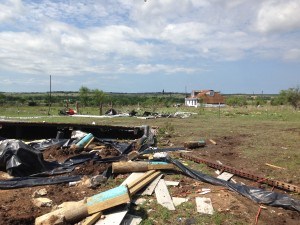A Burnet County home that was picked up and carried 100 yards by a tornado last month, was reinforced according to its owner, Trenton Ashworth.

The National Weather System reported that the EF-2 tornado that hit the Texas county on the evening of June 12 had estimated peak winds of up to 125 mph. According to the report, five people were home at the time and took cover in their bathroom.
Local news reports indicated that when the Ashworths built the home they had steel beams placed underneath the floor, as well as five nails per square inch securing the floor and roof to the frame of the house.
According to the Insurance Institute for Business & Home Safety, homes can be strengthened to withstand wind events like the Texas tornado that hit the Ashworth home. about $3,000, IBHS outlined the following features that can make a home more resilient to severe weather events:
- Hurricane straps that tie the roof to the walls, the walls to the floors, and the first story to the foundation, which creates a continuous load path and helps keep the house together when high winds try to tear it apart;
- High wind-rated siding;
- High wind-rated roof covering;
- A front door that opens out instead of in;
- Ring shank nails, rather than smooth nails or staples to attach roof shingles and siding;
- A sealed roof deck to prevent wind-driven rain from getting inside the house; and,
- 5/8-inch plywood roof decking, instead of ½-inch decking.
Leslie Chapman-Henderson, president and CEO of the Federal Alliance for Safe Homes (FLASH), said that building more resilient homes can be done cost effectively.
“We can assert that residents can affordably build to withstand most tornadoes, and there is exciting research and groundbreaking new building code policy that supports this new line of thinking,” said Chapman-Henderson.
Citing statistics from the National Climatic Data Center, the FLASH president said affordable building reinforcement can help homes withstand most storms.
“According to the National Climatic Data Center, 77 percent of U.S. tornadoes are in the EF-0 to EF-1 range and 95 percent have wind speeds less than EF-3 intensity. What this means is that we have an opportunity to use enhanced high wind construction practices to meet the demands and forces of most tornadoes. Furthermore, it’s affordable. A recent cost study revealed that using an average of $0.50 per square foot or $1,000 in metal connectors installed from a home’s roof to its foundation could upgrade a home’s ability to withstand wind uplift from an EF-0 to an EF-2 tornado,” Chapman-Henderson said. “What this means is that a minimal investment of $.50 per square foot or $1,000 for a 2,000 square foot home will help save lives and minimize property damage for all but the most violent tornadoes. Of course, we always recommend construction of an ICC/NSSA 500 certified tornado shelter or tornado safe room constructed using FEMA 320 or 361 as the ultimate life safety protection from tornadoes of any intensity, up to and including EF-5.”
FLASH drafted a white paper this year, “Building Codes: The Foundation for Resilience”, that examines the nation’s building code system and provides recommendations to strengthen, standardize and enforce them.
Late last month, Nationwide Insurance called on federal and state governments to introduce and pass legislation that would provide incentives for consumers, homebuilders and contractors to build or reinforce homes and small businesses using the IBHS construction and retrofit standards.
“Losses that follow a natural catastrophe are not just financial in nature. Recovering from a hurricane or other natural disaster takes an emotional and psychological toll on families, business owners and communities that often far outweigh the financial cost of a loss,” said Mark Pizzi, president and chief operating officer of Nationwide Insurance.
Incentives like building permit rebates, state-level tax incentives, along with state and federal grants could lead to more resilient communities by offsetting some of the costs, the insurance giant said.
“Post-storm recovery efforts can require a significant allocation of federal and state funds,” said Pizzi, who also serves as the IBHS board chairman. “Providing these fortification incentives before a storm hits could result in dramatic savings to our government and ultimately, to taxpayers.”
While government incentives are critical, Pizzi said insurers also must do their part to motivate policyholders to fortify homes and businesses by providing incentives of their own.
“Insurance companies can offer discounts to consumers and business owners who fortify their structures. They also can offer insurance products that will help rebuild storm-damaged homes and businesses to FORTIFIED standards,” said Pizzi. “For example, consumers who purchase Nationwide’s Better Roof Replacement product will have their damaged roof replaced with one that is built to withstand high wind and damaging hail.”
Nationwide is already seeing the positive impacts of IBHS’ stronger, safer FORTIFIED standards on a small scale in Mississippi. Nationwide Insurance worked with state regulators to be the first carrier in the state to offer mitigation credits on homeowners’ insurance to property owners ravaged by Hurricane Katrina. The hope is that more homeowners, business owners and insurers will follow suit.
“By cobbling together a variety of meaningful financial incentives, we can effectively motivate property owners and builders to take steps that will make homes and businesses much more resilient – saving many lives and billions of dollars in disaster response and recovery expenditures,” said Julie Rochman, president and CEO, IBHS.
Was this article valuable?
Here are more articles you may enjoy.

 CoreLogic Report Probes Evolving Severe Convective Storm Risk Landscape
CoreLogic Report Probes Evolving Severe Convective Storm Risk Landscape  Beyond the Claim: How Social Canvassing is Transforming Insurance Fraud Detection
Beyond the Claim: How Social Canvassing is Transforming Insurance Fraud Detection  EVs Head for Junkyard as Mechanic Shortage Inflates Repair Costs
EVs Head for Junkyard as Mechanic Shortage Inflates Repair Costs  DraftKings Sued Over ‘Risk-Free’ Bets That Were Anything But
DraftKings Sued Over ‘Risk-Free’ Bets That Were Anything But 